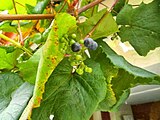Vitis coignetiae
| Crimson glory vine | |
|---|---|

| |
| Vitis coignetiae leaves | |
| Scientific classification | |
| Kingdom: | Plantae |
| Clade: | Tracheophytes |
| Clade: | Angiosperms |
| Clade: | Eudicots |
| Clade: | Rosids |
| Order: | Vitales |
| Family: | Vitaceae |
| Genus: | Vitis |
| Species: | V. coignetiae
|
| Binomial name | |
| Vitis coignetiae | |
| Varieties | |
| Synonyms | |
|
V. amurensis var. glabrescens (Nakai) Nakai [possibly syn. of V. coignetiae var. glabrescens, not V. coignetiae][1][2] | |
Vitis coignetiae, called crimson glory vine, is a plant belonging to the genus Vitis that is native to the temperate climes of Asia, where it can be found in the Russian Far East, (Sakhalin); Korea; and Japan (Hokkaido, Honshu, Shikoku). It was described botanically in 1883.[1] It is called meoru (머루) in Korean and yama-budo (ヤマブドウ) in Japanese.
History
[edit]The species name is dedicated to Marie Coignet, née Sisley,[3] who reportedly brought seeds back from a trip to Japan with her husband in 1875.[4]
This vine was also reported in 1884 snowy regions of Japan by Henri Degron sent to East Asia to seek wild vines resistant to Phylloxera. Degron sent specimens to a Professor Planchon of Montpellier who named them Vitis coignetiae but did not retain them due to their low resistance to phylloxera. Degron planted a vineyard in Crespières, Île-de-France where one of the vines reached a length of 32.8 meters and a height of 2.8 meter. In the cooler Norman climate the vine produces a bitter wine, rich in color and extract.[citation needed]
Description
[edit]The vine is very vigorous, with grey-brown, tomentose shoots. The deciduous leaves are large (10-25 cm in diameter), simple, orbicular, toothed, with 5-15 cm long petiole. Dark green during the growing season, they turn red-orange in autumn.[5]
Wild vines can be male, female or hermaphrodite. Clusters are large with small, purple-black, seeded berries. It is found in the mountainous regions of Japan and up to 1300 m altitude in Korea.[citation needed]
Uses
[edit]
In East Asia it is grown as an ornamental plant for its crimson autumn foliage; and as an Oriental medicinal plant.[citation needed]
It is a recipient of the Royal Horticultural Society's Award of Garden Merit.[6]
It is used to produce wines in Korea and Japan. These are at first bitter, but softened with the addition of sugar.[citation needed]
Chemistry
[edit]The plant contains the stilbenoids ε-viniferin[citation needed] and rhapontigenin.[7]
Gallery
[edit]- Vitis coignetiae
-
Vitis coignetiae leaves.
-
Vitis coignetiae vine growing in Cheshire, United Kingdom.
-
Vitis coignetiae fruit cluster.
-
Vitis coignetiae berries.
-
The ornamental grape autumn colors. Growing in Victoria, Australia.
-
Vitis coignetiae in Northern France.
See also
[edit]- Vitis 'Ornamental Grape', a nonfruiting ornamental grapevine cultivar, also known as 'crimson glory, grown for its autumn foliage
Sources
[edit]- ^ a b c d "Vitis coignetiae". Germplasm Resources Information Network. Agricultural Research Service, United States Department of Agriculture. Retrieved October 20, 2009.
- ^ a b "Vitis coignetiae var. glabrescens". Germplasm Resources Information Network. Agricultural Research Service, United States Department of Agriculture. Retrieved October 20, 2009.
- ^ "Family tree of Marie Élisa Octavie SISLEY". Geneanet. Retrieved 2024-08-08.
- ^ "Vitis coignetiae - Trees and Shrubs Online". www.treesandshrubsonline.org. Retrieved 2024-08-08.
- ^ "Vitis coignetiae | Landscape Plants | Oregon State University". landscapeplants.oregonstate.edu. Retrieved 2024-08-08.
- ^ RHS Plants. Available at: https://www.rhs.org.uk/plants/19030/Vitis-coignetiae/Details [accessed 15/02/21]
- ^ Jung, D. B.; Lee, H. J.; Jeong, S. J.; Lee, H. J.; Lee, E. O.; Kim, Y. C.; Ahn, K. S.; Chen, C. Y.; Kim, S. H. (2011). "Rhapontigenin inhibited hypoxia inducible factor 1 alpha accumulation and angiogenesis in hypoxic PC-3 prostate cancer cells". Biological & Pharmaceutical Bulletin. 34 (6): 850–855. doi:10.1248/bpb.34.850. PMID 21628883.






